08/02/2017
Print PageDKTK Berlin: The Variety of the Tumor in 3D

“Cells of one and the same tumor can have very different genetic properties and therefore also respond to therapy quite differently,” explained Christine Sers of the Berlin Charité, the leader of the study published in the science magazine Nature Communications. It was not previously known, just what sort of pattern these genetic differences adhered to.
In order to find that out, the researchers dissected a colon tumor into 68 samples from various tissue regions and analyzed the one hundred most frequently altered genes. Afterwards, they reconstructed the spatial layout of the genetic differences in a three-dimensional model. “Due to the high resolution, it was even possible to discern the genetic differences that were only present in a small percentage of the tumor cells,” emphasized Soulafa Mamlouk, principal author of the study.
Interestingly, the individual tumor regions differed only slightly in the manner and number of coding mutations, but showed highly variable gene copy numbers in numerous genes. The researchers found countless gene copy numbers in the transition area from the outer to the inner tumor region, among them the gene BRCA2, which plays a decisive role in breast cancer. They also found a high number of gene copy gains, such as for the HDAC2 gene, which encodes a central enzyme in gene regulation, in the invasive tumor area – the area which grows into neighboring healthy tissue.
Depending on the stage, the tumors heterogeneity was defined primarily by the gene copy numbers. This became clear when the researchers compared the primary tumor with the various metastases of 27 patients. Genes such as CDX2 and WFDC2, which facilitate metastasis development and tumor growth, were amplified in the metastases, while the tumor suppressor gene SMAD4 had a particularly low gene copy number.
“Our results indicate that tumor progression and therapy behavior are defined by gene amplification and gene deletion,” said Christine Sers. “Tumor cells where entire chromosome sections or whole genes are being amplified, are genetically particularly adaptable and could possibly become resistant to therapy more quickly.” The study also shows, that current biopsies don’t always provide enough information about all tumor features. The results of the researchers could help to create more nuanced profiles and improve current routine diagnostics.
Mamlouk, S. et. al.: DNA copy number changes define spatial patterns of heterogeneity in colorectal cancer. In: Nature Communications (25 January 2017) Doi:10.1038/ncomms14093
Pictures and video for press releases may be downloaded at:
www.dkfz.de/de/presse/pressemitteilungen/2017/bilder/BRCA2-rotation.jpg
www.dkfz.de/de/presse/pressemitteilungen/2017/bilder/Supplementary-movie.gif
Caption for the picture:
The three-dimensional tumor model shows in which areas the copy number of the gene BRCA2 is changed in the CRC tumor. The researchers found a high gene copy number in the inner tumor area (dark red), while the copy number in some outer areas was barely increased (light red) or remained unchanged (white).